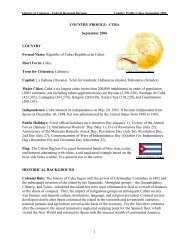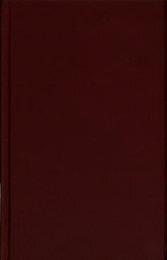Anton Webern's Six Pieces for Ocrhestra, op. 6, Arrangement for ...
Anton Webern's Six Pieces for Ocrhestra, op. 6, Arrangement for ...
Anton Webern's Six Pieces for Ocrhestra, op. 6, Arrangement for ...
You also want an ePaper? Increase the reach of your titles
YUMPU automatically turns print PDFs into web optimized ePapers that Google loves.
The chamber version of <strong>Webern's</strong> <strong>op</strong>. 6 has survived only in a set of parts, which,<br />
after the composer's death, was in the possession of Amalie Waller (<strong>Webern's</strong> eldest<br />
daughter) and later found its way to Hans Moldenhauer's Webern Archive in<br />
Spokane (in 1961), and then to the Paul Sacher Foundation in Basel (in 1984). This<br />
set of parts--<strong>for</strong> flute (also piccolo), oboe, clarinet (also bass clarinet), percussion,<br />
harmonium, piano, violin I, violin II, and viola--is not quite complete; marked cues<br />
suggest that the scoring also included cello and double bass. The full score there<strong>for</strong>e<br />
had to be reconstructed--a task that was first undertaken, in 1968, by Edwin<br />
Haugan, Hans Moldenhauer's long-time assistant. Haugan's version, a c<strong>op</strong>y of<br />
which is preserved in the Webern Collection of the Paul Sacher Foundation, was<br />
used, together with the original set of parts, both <strong>for</strong> a per<strong>for</strong>mance by the ensemble<br />
die reihe in 1970 and <strong>for</strong> the printed edition issued by Universal Edition. 10 Neither<br />
score is entirely reliable, however: in Haugan's reconstruction the double bass was<br />
omitted, 11 and in the published version the reference to this instrument in measures<br />
1819 of No. 2 was overlooked. 12 In addition to this problematic documentation-doubly<br />
problematic since the manuscript score (or annotated print of the original<br />
orchestral version) from which the per<strong>for</strong>mance material was extracted is also lost-the<br />
parts were written by several scribes. Only the ones <strong>for</strong> the first and second<br />
piece appear throughout in <strong>Webern's</strong> hand, while those <strong>for</strong> the other pieces were to a<br />
large extent written either by Alban Berg (No. 5), or by two unidentified c<strong>op</strong>yists<br />
(Nos. 3, 4, and 6). Moreover, all parts are marked with pencil corrections and<br />
per<strong>for</strong>mance directions, entered by the players in the course of rehearsals. Thus, we<br />
are confronted with a highly heterogeneous source, which, even in its outward<br />
appearance, bears witness to the joint ef<strong>for</strong>ts characteristic of the Verein concerts.<br />
Still, the authenticity of the musical text as such is not problematic (minor<br />
discrepancies between the parts notwithstanding), 13 since Webern supervised both<br />
the production of parts and the rehearsals, and since he conducted--though<br />
apparently not to his full satisfaction--all four per<strong>for</strong>mances of this version (on<br />
January 23 and 31, and on May 12 and 13, 1921). 14<br />
With his arrangement of the <strong>Six</strong> <strong>Pieces</strong> <strong>for</strong> Orchestra, Webern returned to a work<br />
that he head composed in 1909 and published privately four years later. 15 Shortly<br />
after publication, the composition received its premiere in the famous<br />
"Skandalkonzert" on March 31, 1913, which also included pieces by Alexander<br />
Zemlinsky, Arnold Schoenberg, Alban Berg, and Gustav Mahler. 16 The <strong>Six</strong> <strong>Pieces</strong><br />
feature a larger scoring than the composer had ever used be<strong>for</strong>e or would ever use<br />
again: 4 flutes (also 2 piccolo flutes and 1 alto flute), 2 oboes, 2 English horns, 3<br />
clarinets (also 1 clarinet in E-flat), 2 bass clarinets, 2 bassoons (also 1<br />
contrabassoon), 6 horns, 6 trumpets, 6 trombones, 1 bass tuba, 2 harps, celesta,<br />
timpani, and other percussion instruments, and a large string group which is often<br />
subdivided. It is clear, there<strong>for</strong>e, that the chamber arrangement called <strong>for</strong> drastic<br />
changes in scoring, on;y three of which of the most common types will be briefly<br />
considered here.



![Albert Einstein Papers [finding aid]. Library of Congress. [PDF ...](https://img.yumpu.com/21604228/1/190x245/albert-einstein-papers-finding-aid-library-of-congress-pdf-.jpg?quality=85)





![American Colony in Jerusalem Collection [finding aid]. Library of ...](https://img.yumpu.com/17941275/1/190x245/american-colony-in-jerusalem-collection-finding-aid-library-of-.jpg?quality=85)



![Piccard Family Papers [finding aid]. - American Memory - Library of ...](https://img.yumpu.com/17941234/1/190x245/piccard-family-papers-finding-aid-american-memory-library-of-.jpg?quality=85)


